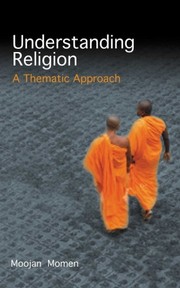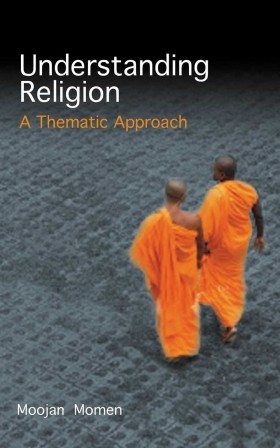Check nearby libraries
Buy this book

A thematic presentation of the role of religion in human society, from traditional cultures to the modern world. Arranged into three main fields of enquiry – religious experience and its expression; conceptual aspects of religion; and religion in society – this study draws from all major religious traditions in the world, as well as a variety of non-religious disciplines such as psychology, philosophy, and sociology.
Originally published as "The Phenomenon of Religion - A Thematic Approach" in 1999.
Check nearby libraries
Buy this book

Previews available in: English
Showing 3 featured editions. View all 3 editions?
| Edition | Availability |
|---|---|
|
1
Understanding Religion: A Thematic Approach
2019, Oneworld Publications
in English
1786077477 9781786077479
|
zzzz
Libraries near you:
WorldCat
|
|
2
Understanding Religion: A Thematic Approach
2009, Oneworld Publications
Paperback
in English
1851685995 9781851685998
|
aaaa
Libraries near you:
WorldCat
|
|
3
Understanding Religion: A Thematic Approach
July 25, 2008, Oneworld Publications
Paperback
in English
1851685995 9781851685998
|
zzzz
Libraries near you:
WorldCat
|
Book Details
Table of Contents
List of Maps and Timelines. xii
Notes and Acknowledgements. xiii
INTRODUCTION. 1
The Study of Religion. 2
Three Aspects of Religion. 4
The Religions of the World. 7
Concept and Category. 16
PART I UNDERSTANDING RELIGION. 19
CHAPTER 1 THE CONCEPT OF RELIGION. 21
What is Religion?. 21
Definitions of Religion. 26
The Religious Person or Society. 28
CHAPTER 2 RELIGION EAST AND WEST - A GENERAL SURVEY. 31
The Nature of Ultimate Reality. 31
Concepts of Suffering and Evil. 34
The Path to Salvation. 34
The Goal of Salvation. 35
Ritual and Religious Practices. 36
Time and Creation. 36
Theism and Monism. 36
The Universality of Modes of Religious Thought. 38
Mutual Attitudes of Theism and Monism. 41
Relativism. 41
Chinese and Japanese Religion. 43
Primal Religions. 46
The Modern World. 50
CHAPTER 3 THEORIES OF RELIGION. 52
Sociological and Anthropological Theories. 52
Psychological Theories. 61
Philosophical and Historical Theories. 65
Theological and Normative Theories. 69
Typologies of Religion. 73
Approaches to the Study of Religion. 77
The Goal of the Study of Rehgion. 82
PART II THE RELIGIOUS EXPERIENCE AND ITS EXPRESSION. 85
CHAPTER 4 THE RELIGIOUS EXPERIENCE. 87
Describing the Central Experience of Religion. 87
Types of Religious Experience. 92
The Religious Crisis. 98
A Psychological Model of the Stages of Religious Experience. 99
Mediators of Religious Experience. 100
The Social Influence on Religious Experience. 114
CHAPTER 5 PATHWAYS TO RELIGIOUS EXPERIENCE. 117
Ritualism. 117
Legalism. 120
Evangelism. 123
Social Reformism. 126
Asceticism. 129
Monasticism. 130
Gnosticism. 132
Mysticism. 135
The Evolution of the Pathways. 137
A Classification of Religious Groups. 138
CHAPTER 6 FAITH, BELIEF AND CONVERSION. 141
The Nature of Faith and Belief. 141
Acquisition of Religious Belief and Behaviour. 145
The Language of Faith. 148
Conversion, Reform and Renewal. 151
The Social Psychology of Conversion and Religious Commitment Motifs of Religious Conversion. 158
The Conversion of Whole Societies. 161
The Religious Life. 163
CHAPTER 7 TOWARDS A SCIENTIFIC UNDERSTANDING OF RELIGIOUS EXPERIENCE. 166
Piaget and the Perceptual Development of Children. 167
State-Dependent Learning and State-Bound Knowledge. 170
Fischer and a Map of Mental States. 173
The Neurophysiological Basis of Religious Experience. 176
Sperry and Split-Brain Experiments. 178
Types of Religious Experience. 179
Cautionary Notes. 180
PART III CONCEPTUAL ASPECTS OF RELIGION. 183
CHAPTER 8 THE NATURE OF REALITY. 185
The Nature of Ultimate Reality. 186
Transcendent Worlds and Beings. 199
Revelation and Enlightenment. 203
Human Nature. 204
The Physical World. 206
Time, the Origins and the End of the World. 207
Epistemology. 211
CHAPTER 9 SUFFERING, SACRIFICE AND SALVATION. 213
Evil, Sin and Suffering. 213
Sacrifice and Detachment. 225
Martyrdom. 230
Concepts of Liberation and Salvation Before and After Death. 231
CHAPTER 10 THE PROMISE OF A FUTURE SAVIOUR. 242
Descriptions of the Coming of the World Saviour. 242
A Typology of Future Saviours and Millennialist Movements. 254
Eschatology and the New Religious Movements. 262
Disconfirmed Prophecy. 262
Causes of Millennialist Movements. 264
CHAPTER 11 ARCHETYPE, MYTH AND THE SACRED. 268
Some Religious Archetypes and Myths. 269
Sacred Place and Sacred Time. 277
Religious Symbols. 278
Ritual. 279
Rites of Passage. 281
The Function of Myth and Symbol. 284
Myth and Religious History. 286
Myth and Modernity. 295
PART IV RELIGION IN SOCIETY. 299
CHAPTER 12 COMPARATIVE RELIGIOUS HISTORY. 301
The Founders of the Religions. 301
The Development of a Religion. 317
Schism and Heresy. 322
From Personal Piety to Organized Religion. 323
The Nature of the Historical Record. 332
CHAPTER 13 RELIGION AND ETHICS. 338
Moral Development. 341
The Foundations of Religious Ethics. 342
The Boundaries of Ethical Action. 346
Ethics and Social Laws. 352
Social and Environmental Ethics. 352
CHAPTER 14 FUNDAMENTALISM AND LIBERALISM. 363
Characteristics of Fundamentalism and Liberalism. 364
Towards a Social Definition of FundamentaUsm and Liberalism. 375
The Social and Intellectual Basis. 376
The Psychological Basis. 378
Fundamentalism and Modernity. 380
A Historical Perspective. 382
CHAPTER 15 OFFICIAL RELIGION AND POPULAR RELIGION. 386
The Relationship between Official and Popular Religion. 386
The Evolution of Popular Religion. 391
Three Examples of Popular Religion. 394
CHAPTER 16 RELIGION, POWER AND GOVERNMENT. 404
Religion and Legitimation. 405
Religion and the State. 412
Religion and Politics. 419
Civil Religion. 425
Power and the Religious Professional. 426
CHAPTER 17 RELIGION AND GENDER. 432
The History and Characteristics of Patriarchy. 432
The Suppression of Women by Religion. 435
The Eternal Female Archetype. 442
Religion and Sexuality. 444
The Modern Debate. 447
The Feminist Study of Religion. 449
CHAPTER 18 RELIGION AND THE ARTS. 455
Art and Popular Religion. 455
Art and the Symbolic Universe. 459
The Historical Development of Religious Art. 462
CHAPTER 19 RELIGION IN THE MODERN WORLD. 475
Social Challenges to Religion. 476
The Intellectual Challenge to Religion. 481
Religious Adaptations to the Modern World. 485
The Response of Religion in Traditional Societies. 490
Ecumenism and Interreligious Dialogue. 492
A Survey of Religions Today. 493
New Religious Movements. 508
Religious Freedom. 516
Religion and the Media. 519
Religion as Meaning. 524
CONCLUSION. 528
From Individual Experience to Social Expression. 530
The History of a Religion. 532
Analysis and Categorization. 534
The Definition of Religion. 535
GLOSSARY. 538
NOTES. 546
BIBLIOGRAPHY. 570
INDEX. 586
LIST OF MAPS AND TIMELINES.
Map showing the Spread of Buddhism. 10
Buddhism timeline. 11
Christianity timeline. 13
Map showing the Distribution of World Religions. 32
Chronology of Religious Events in the Middle East and India. 302
Map showing the Major Holy Places and Migrations of the Prophet-Founders of the World Religions. 314
Map showing the Spread of Islam. 318
Baha'i Faith timeline. 329
Hinduism timeline. 422
Islam timeline. 423
Judaism timeline. 495
Map showing the Spread of the Baha'i Faith up to 1950. 500
TABLES AND FIGURES.
Table 1.1 Worldly Values Versus Religious Values. 29
Table 2.1 Differences Between Eastern and Western Religious Thought. 37
Table 3.1 Structural Analysis by Lévi-Strauss of Three Myths Regarding the Origins of Tobacco. 57
Figure 5.1 Social Expressions of the Central Experience of Religion: The Pathways to Salvation or Liberation. 118
Table 5.1 Religious Experience and the Pathways to Salvation. 121
Table 6.1 Conversion Motifs. 159
Table 6.2 Psychological Comparison of Different Modes of Religious Life. 164
Figure 7.1 Pathways to Altered States of Consciousness. 174
Table 9.1 Words used for Salvation in this Life and After. 238
Table 10.1 Comparative Eschatology. 243
Table 12.1 Lives of the Founders of World Religions. 310
Table 14.1 Fundamentalism and Liberalism. 368
Figure 14.1 The Split between Fundamentalism and Liberalism. 384
Table 15.1 Differences between Official and Popular Religion in Theravada Buddhism. 396
Table 17.1 Religious Role Model for Women. 442
Table 19.1 Estimated Number of Adherents of World Religions. 504
Table 19.2 Rate of Growth and Spread of World Religions. 505
Edition Notes
Classifications
The Physical Object
ID Numbers
Source records
marc_claremont_school_theology MARC recordBetter World Books record
Internet Archive item record
marc_claremont_school_theology MARC record
amazon.com record
Excerpts
The first blow to religion came through its increasing loss of social control. In the traditional structure of Hindu, Muslim or even medieval Christian society, religion controlled all aspects of life. Religious institutions were the main pathways for acquiring an education, for obtaining medical treatment, and for the poor to obtain relief. Even such matters as the functioning of craft guilds was to some extent under religious control. Gradually, however, a functional differentiation of society occurred, leading to the increasing autonomy of its different parts. In the last hundred years, in most countries, the modern secular state or other secular institutions have taken over from the religious establishment control of such areas as medicine, education and welfare provisions for the poor.
The second blow to the religious perspective came with the increasing importance given to individualism in the modern world. Previously the individual was willing to allow the religious perspective to predominate over his or her individual views. Today, there is an increasing emphasis on the individual's own point of view. This leads to a loss of the authority of the central institutions of the religion. As a corollary to this individualism came a belief in the beneficial effects of self-interest as the guiding principal of human action, a development that contradicts the teachings of most of the established religions.
The second blow to the religious perspective came with the increasing importance given to individualism in the modern world. Previously the individual was willing to allow the religious perspective to predominate over his or her individual views. Today, there is an increasing emphasis on the individual's own point of view. This leads to a loss of the authority of the central institutions of the religion. As a corollary to this individualism came a belief in the beneficial effects of self-interest as the guiding principal of human action, a development that contradicts the teachings of most of the established religions.
Page 479,
added by Wiki.
Community Reviews (0)
Feedback?| August 2, 2020 | Edited by ImportBot | import existing book |
| July 27, 2020 | Edited by MARC Bot | import existing book |
| November 29, 2013 | Edited by Wiki | Formatting |
| November 29, 2013 | Edited by Wiki | Added subtitle and title of original publication |
| December 9, 2009 | Created by WorkBot | add works page |











